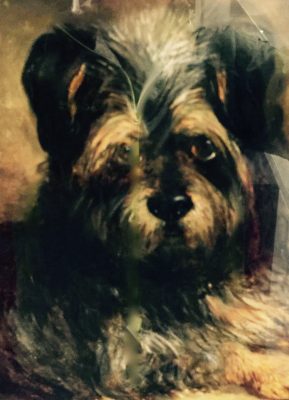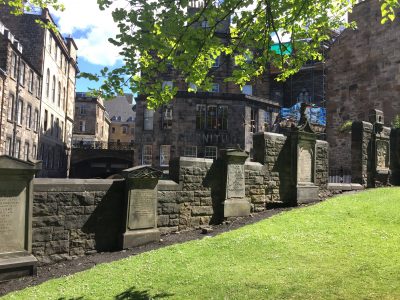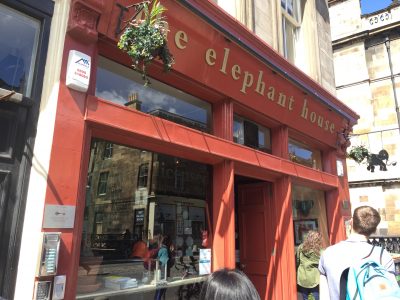 This is an oil painting of a Skye Terrier named Bobby. He lived as the companion of a police officer named John Grey whose beat was the Grassmarket between Greyfriars Church and Edinburgh Castle in Edinburgh, Scotland.
This is an oil painting of a Skye Terrier named Bobby. He lived as the companion of a police officer named John Grey whose beat was the Grassmarket between Greyfriars Church and Edinburgh Castle in Edinburgh, Scotland.
In 1858, Bobby’s master, John Grey, died of tuberculosis and for fourteen years Bobby spent most of each day, rain and snow and heat, sitting on the grave of his dead friend, John Grey. He slept on the grass at the foot of the headstone day in and day out for 14 years.
Due to dog laws of the 19th century, and without anyone to buy a license for Bobby, he was scheduled to be killed as a stray when, a day before the round-up his license was purchased by a local Baroness who then had a sculpture done of him for the graveyard.
I spend much of the day in this church and graveyard yesterday. It was the first Covenanter’s church (the Covenanters were a group of 17th century church leaders who rejected the hierarchy of the church and wanted to seed a revolution to return worship and polity back to an early-church system of friendship with an emphasis on care for the poor and marginalized…) The second day of my pilgrimage was dedicated to a walk to, and long meditation in, this church to pray about and think on what a Covenanter’s revolt might look like in the 21st century. It was the Covenanter Movement which began what we now know as modern education and helped to begin the end of Bishop’s and King’s power in Scotland.
 This little grave yard was immediately behind other place of Pilgrimage for me, The Elephant House, is a small coffee shop whose back windows look out onto the graveyard and where J. K. Rowling wrote her early Harry Potter novels, taking the names of her characters from the gravestones she could see from her seat by the window. ( In this image, you can see the windows through which she looked out onto the graveyard – they are those windows just beneath the tree branches and above the third gravestone from the left. I am writing this meditation while seated in this coffee shop and by these windows.)
This little grave yard was immediately behind other place of Pilgrimage for me, The Elephant House, is a small coffee shop whose back windows look out onto the graveyard and where J. K. Rowling wrote her early Harry Potter novels, taking the names of her characters from the gravestones she could see from her seat by the window. ( In this image, you can see the windows through which she looked out onto the graveyard – they are those windows just beneath the tree branches and above the third gravestone from the left. I am writing this meditation while seated in this coffee shop and by these windows.)
I wanted to make a pilgrimage to the coffee shop to honor the courage it took for a single mother to begin a writing career against all odds in order to feed her children. She went back and forth between this coffee shop and the city Library across the street in order to capitalize on the free heat and water they provided, given that she lived in a dank, cold hovel trying to support her children without any financial support form her ex-husband. She is, today, the greatest philanthropist Edinburgh has ever seen.
These two stories of the terrier and the author overlapped for me as I sat were she sat and looked out over those same gravestones, even John Grey’s. Life can be terribly hard at times, but there is a goodness which seems to have a mathematical truth behind it.
God moves mysteriously. Never early. Rarely the way we ask. But God moves not so much within ecclesial statements but rather more in the little dog whose connection to his friend can remain even with six feet of dirt between them for 14 years. And God moves in the determination of a mother who would find a way to buy groceries and an education for her children by writing books in a coffee shop to keep warm.
I am wondering about the lives of the saints. Are they just the people we place in our stained glass or are there saints all around us, all the time? Might God’s magic math encircle humanity, weaving throughout all of it; a saintly abbot and a saintly terrier – a saintly mystic and a saintly author – a saintly cop and a saintly monk and a saintly teacher? Might we church-goers be disappointed to find that heaven is filled with, well, everyone – and that the head table is filled with people like J. K. Rowling and John Grey and his little, faithful terrier?


What about the Baroness who saved the dog? She’s a Saint too!! Wonderful story!
This is lovely Charles. Have a wonderful time in Scotland. A good time of year to be there.
Nicki